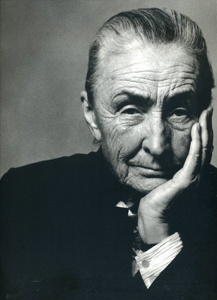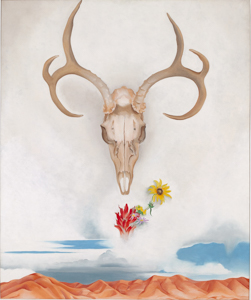GEORGIA O'KEEFFE (1887, 1986)
American Painter


Horst became acquainted with O’Keeffe’s work at the 1977? Exhibit in San Francisco. He had known of her work, but suddenly recognized an artistic affinity. He was impressed by the way she mixed abstraction, expressionism and surrealism within representational paintings. Although O’Keeffe worked mostly from nature, and Horst from his subconscious and imagination, their interpretations of modernism have a great deal in common. As with other artists, Horst took encouragement from this commonality.
"I found I could say things with color and shapes that I couldn't say any other way - things I had no words for."
-- Georgia O'Keeffe
Horst had already been surprised by the ability photographers like Edward Weston to mix modern concepts into purely representational images. O’Keeffe’s marriage to Alfred Stieglitz gave her similar inspiration. Much of her work begins with spiritual, psychological or surreal concept that she builds up out of representational imagery. This approach allowed her to go beyond the vocabulary of pure abstraction or expressionism.
Horst’s fascination with plants, especially cacti and succulents dovetails with O’Keeffe’s fascination with flowers. Horst could have made an entire career out of botanicals. Standing in front of Ice Plant, I asked him why he hadn't done a whole series of paintings like that. He replied "because it's already been done". I think he was referring to O'Keeffe and Weston, among others.
O’Keeffe’s struggled to achieve acclaim among her mostly male contemporaries. They tended to dismiss her work as too feminine, too representational and therefore not significant. Her work was even criticized for being too Freudian and suggistive of female genitalia. However, over time appreciation of the importance of her work has increased dramatically, so that now she has eclipsed most, if not all, of her male cohort.
O’Keeffe’s life was a work of art too. From New York City, she sought out a more spiritual and contemplative life in New Mexico. In her home in Abiquiú, she surrounded herself with a simple yet stunningly beautiful objects, many of which found their way into her paintings. Her clothing and lifestyle exemplified the unique aesthetic that permeated her life and art.
Early in 1986, Horst and Barbara took an extended road trip through the southwest. This was the impetus for his southwest paintings linked below. One of their stops was O'Keeffe's Abiquiú house in Horst's photograph below. Somewhat synchronistically, they arrived nearly the day that she passed away.

Both Horst and O'Keeffe had such an intense desire to explore beauty in all its forms, they both built environments that gratfied and inspired that need. Horst's Fairfax garden was as much art as avocation. Not satisfied, he would constantly arrange small still lifes around the house, always arresting in their novelty and simplicity. A few of them appeared in paintings.
In Navaho Country I
In Navaho Country II
In Navaho Country III
Sheep Herder
Goat Woman